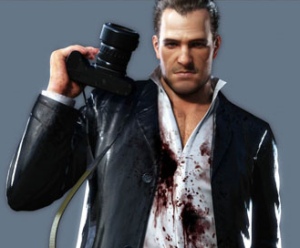 Title: Dead Rising
Title: Dead Rising
Developer: Capcom
Publisher: Capcom
First Released: September 8, 2006
Available on: Xbox 360 only
Metacritic Score: 85/100
When the zombie apocalypse comes (when, not if), I’d like to believe it will be the slow, shambling Romero-style zombies that make such easy targets for a well-swung cricket bat, as opposed to the charging, snarling, red-eyed “infected” that have become the norm since 28 Days Later. Either way, I’m not entirely sure I’d be comfortable dropping myself into the middle of a full-scale zombie invasion just for the sake of a story, but that’s precisely what freelance photojournalist Frank West does in Capcom’s Romero-riffing action-horror Dead Rising.
It’s the perfect set-up for spending 72 hours (or 6 in real-time) inside a zombie-infested shopping mall, and gives Capcom the ideal tough-guy, every-man protagonist to get in and get the job done. The beauty of Dead Rising is that Frank is never really scared, so you’re not either. This is no survival horror, it’s about having fun coming up with novel ways to make the dead stay dead, all glossed over with a layer of the irreverent, almost crass black comedy that made films like Shaun of the Dead and Zombieland so entertaining.

LET’S BE FRANK: As a protagonist, Frank West is perfect. He’s a grizzled, Cro-magnon, Mel-Gibson-on-a-bad-day looking son of a bitch who’s not afraid to get his hands and feet dirty if it means landing the scoop. “I’ve covered wars, buddy!” he snarls at the pilot reluctantly flying him towards the Willamette Park View Mall above a town that’s already gone to hell. Frank is not afraid; he’s focused, intrepid, tough as nails.
The opening 5 minutes of Dead Rising make for one of the best scene-setting introductions ever, as through the lens of Frank’s trusty camera we see (among other things) a survivor unsuccessfully attempting to defend himself from atop a car before being pulled down to his doom, and a plucky young woman on a rooftop who runs out of ammo and throws her gun at the horde of zombies pushing her towards the edge, before leaping to her death rather than risking infection. Where many other games would give you a gun and ask you to help people to earn Karma points or fill a Paragon meter, Dead Rising uses this period to remove any illusions about Frank West’s character as he coldly takes photos, earning more PP (that’s Prestige Points) the gorier the shot. This is Frank West, says Dead Rising. He’s no hero, no altruist, no philanthropist; he’s here for the story and nothing but. Which of course makes it seem all the more worthy when, through the course of the story, and thanks to the pressure of greatness, Frank becomes the hero.
You see, unbeknownst to Frank (or most of the world outside Colorado) the Willamette Mall is brimming with the reanimated dead – but it’s also a makeshift shelter/potential tomb for almost 60 survivors, almost all of whom you can save if you put in the time and effort. It says a lot about the seemingly selfish and ruthlessly ambitious Frank West that he would find the time and head-space to even try to rescue folk alongside landing that all-important scoop. Though if he didn’t, Dead Rising would be a pretty short game.
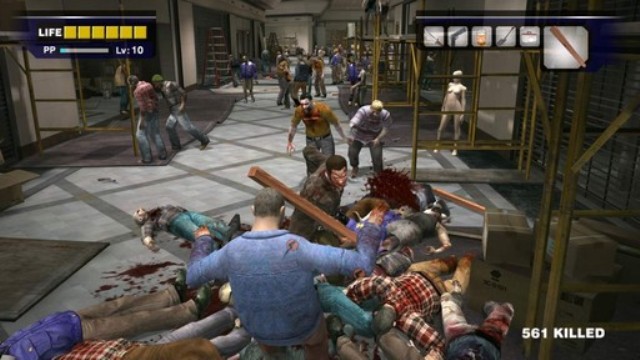
TERMINAL CASE: The player’s primary motivation throughout Dead Rising is the constantly ticking clock. The pilot promises to return in 72 hours, and that’s what you have to play with. Passing at a rate of 12 to 1, those 72 hours equate to 6 in real time, and while there is a certain amount of freedom, if you don’t complete the “Case Files” (what Dead Rising calls its story missions) Frank will lose his chance to crack the mystery and escape the horror.
Bounced between DHS agents Brad and Jessie and the terrorist behind the outbreak, Carlito Keyes and his femme fatale sister Isabella, Frank must complete specific tasks within their allotted time or forfeit the opportunity, and the game, forever. Unfortunately, it’s incredibly easy to get carried away gorging yourself on the smorgasbord of distractions. That said, Dead Rising’s narrative is compelling enough that you want to see how it concludes, at least on your first playthrough. Missing an objective or failing a case rarely results in a Game Over, but rather affects the story in a certain way – or simply strands Frank in Willamette until the countdown ends. Often, time really is against you, too, especially when you factor in the Psychos, Dead Rising’s answer to traditional bosses.
One particularly nasty moment comes when you’re tasked with retrieving medicine for a wounded Brad and have to make it to the supermarket within a certain time. Getting there is easy enough, but then you’re faced with Steven, a crazed shelf-stacker with a tricked-out trolley who comes at you with murder on his mind. Killing him isn’t incredibly hard in of itself, but given that by now your time for the case file is really beginning to get desperate, it’s a bitch of a boss fight. Sometimes simply keeping the Psychos’ hostages alive is a challenge; wait until you see the insane lesbian dominatrix security guard who’s got a bunch of Sorority girls tied up to be tortured with a taser. She’s a treat, for sure.
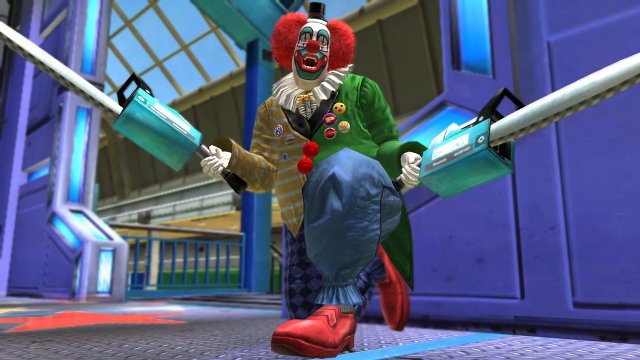
NOT THE BOSS OF ME: The Psychos are a colourful bunch to say the least, and reinforce the increasingly common theme that in the event of a zombie outbreak, the living would likely be more dangerous than the dead. Of course, this being a Capcom game, bosses were always going to figure somewhere, but at least the offerings here are imaginative, and each one is different. Unlike the respawning zombies, once the Psychos are dead, they stay dead – with the exception of the escaped convicts terrorising the Mall’s central leisure park, who, for some reason, will respawn every day, and are among the more infuriating Psychos to boot.
The NPCs are often the highlight of Dead Rising, whether it’s the lingerie model who’s so grateful for being saved that she’ll call you back to the security room safehouse at the 11th hour to snap some saucy shots of her, or someone more integral like Carlito, the terrorist who masterminded the outbreak by stealing a specimen of the artificially-mutated wasp larvae that had caused a similar catastrophe in his hometown, before the government swept in to “cleanse” it. The point is, they’ve all got personalities, and whether you’re fighting them or rescuing them, those personalities come through. In the Psychos it’s an easy sell, as they wear their craziness right their on their sleeves, or their necklace of ears, or their shopping cart of death.
Thankfully, Frank is a hardy chap. Resourceful and adaptable, he can find up to 250 items to use as weapons, or upgrade his abilities to include zombie-crowd-surfing, professional wrestling moves and increased speed, damage and defence. Scattered food items refill health, or he can find a blender in one of the numerous restaurants and mix himself up a special smoothie to add temporary buffs. The weapons range from incredibly useful (samurai sword, Uzi), through bizarre (bowling ball, MegaMan blaster, shower head) to fairly useless (cuddly toy, traffic cone), but Capcom are nothing if not diverse in their design. Coupled with the option to dick around in the clothing stores and experiment with outfits and props, Dead Rising has one of the best approaches to zombie infestation ever. How many other games let you dress up in a blue and white checked Gingham dress, a MegaMan helmet and military issue boots while riding a skateboard around a shopping mall knocking zombies down with a bowling ball?
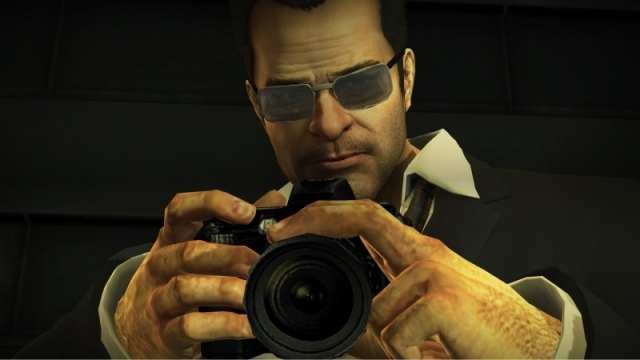
THAT DAMN CAMERA: At the heart of Dead Rising is a straightforward 3rd-Person action game with a clear set of objectives. What makes it special is what Capcom throw into the mix to flesh out the story, bolster the runtime and populate the sandbox: Psychos, survivors, clothing stores, shortcuts. But the most important element both inside and outside the main game is Frank’s camera, the device by which he makes his living. At even the merest possibility of a juicy opportunity, the thing leaps unbidden to his hand like the gun of a trigger happy security guard. Before conscious thoughts of personal safety or incidental heroism come to mind, Frank’s camera is already snapping up scoops and earning him money.
Prestige Points, or PP, are Dead Rising’s version of XP and are earned for particularly cool shots. Photos come in five categories: Action (someone firing a gun, for example), Horror (a survivor copping the business end of a zombie’s teeth), Comedy (slap a traffic cone on the head of a shambling corpse and snap away), Drama (capture a tender moment in the security room, maybe) and Erotica (down Jessie’s top works pretty well). Setting up these opportunities and capturing them is as much fun as anything else Dead Rising lets you get up to, and makes the camera an essential tool throughout.
Although you can only save your game at the security room, Dead Rising employs an interesting mechanic whereby you’re given the option each time of starting a new game with all of your unlocked skills and PP. It makes it easy to get a short boost to begin with when you can run through the opening twenty minutes a few times to upgrade your health and stockpile a weapon or two, but it’s mostly to reinforce the idea that your actions in a playthrough are permanent. Once you miss a case, you can either restart or accept your fate – who knows, you might still save a lot of lives.

SEEN ONE ZOMBIE, SEEN ‘EM ALL: The appeal of Dead Rising is a simple case of the good outweighing the bad. Criticisms were levelled against Frank’s sluggish movements, the unfair difficulty spiking and on-screen text that was unreadable on a standard definition TV (and remember that this was in 2006, when most hadn’t upgraded to HD yet). Despite a petition by consumers and forumites, Capcom held their ground and refused to patch the troublesome text, standing by their decision and ambition to make Dead Rising one of the first truly high definition games.
Besides the critical digs there were also legal wrangles threatening to bury Dead Rising. A lawsuit was brought against Capcom by MKR, the company who owns the rights to both Dawn of the Dead films, citing similarities, but the case was thrown out following the Judge’s ruling that “humans battling zombies in a shopping mall” is “wholly unprotectable”. Of course, there’s also the disclaimer that Capcom themselves put on the box to distance it entirely from the works of George A. Romero.
One thing you can’t fault Dead Rising on is the amount of content. The main game might only last 6 hours (or 8 if you achieve everything necessary to unlock Overtime Mode and get the perfect ending), but with Infinity Mode you get as much zombie killing as you can survive through. A constantly ebbing health bar adds to your woes, but makes it all that much more challenging. Add to that the campaign’s five different endings and the effortless, encouraged replayability and it’s not hard to see why Dead Rising is so popular.
As much as I hate to talk about things like cultural divides or sexism in gaming, there is also the fact that Dead Rising was – and remains – a shining example of a game combining Eastern and Western tropes to deliver a truly unique experience. We all know how much Keiji Inafune likes a boss fight, but here we have almost institutionalised Eastern gameplay mechanics like formulaic bosses, single save files and unforgiving difficulty spikes sitting comfortably inside a wholly Western skin (a game set in an American shopping mall featuring a character like Frank West could only be more Western if everyone in it were wearing Stetsons). Despite what could have been a major clash of styles, it all works, and works incredibly well.
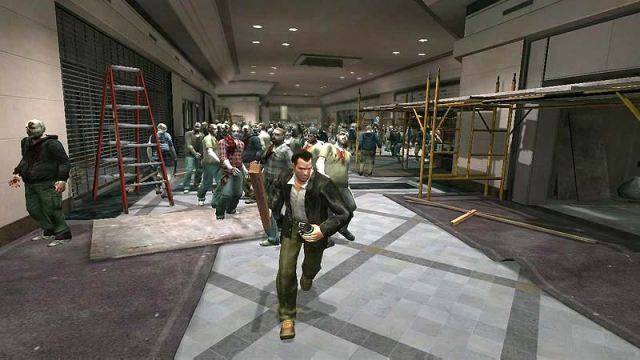
THIS IS MY LEGACY: What we never got, which the original alluded to, was a true sequel to Frank’s story. Left hanging from not one but two cliffs (Frank’s suppressed infection and 50 orphans scattered around America infected by Carlito), the true ending was crying out for closure. Instead we got Dead Rising 2, the story of stunt rider Chuck Greene slaughtering zombies through the Vegas-aping Fortune City and looking for Zombrex (an anti-infection medicine) to save his daughter. The core mechanics remain the same (with the addition of customisable weapons and a larger gameworld, improved graphics and more variety), but it doesn’t finish what Frank began.
West instead returned in 2011’s Dead Rising 2: Off the Record, replacing Greene in a non-canonical re-imagining of Dead Rising 2. It follows on roughly from Dead Rising, casting Frank as a fallen celeb following his brief bout of fame for the goings-on at Willamette, and maintains the motivation of finding Zombrex as Frank must battle his own infection. It’s not a direct sequel, but at least it’s more Frank West.
The Wii edition, subtitled Chop Till You Drop, was probably a bigger departure than Chuck Greene’s tale purely because of the changes Capcom made, reducing the number of zombies on screen at any time (the Wii was never going to cope with the supposed 800 that the Xbox 360 could handle), less melee weapons and more firearms, the complete removal of Frank’s photography and the inclusion of pointless minigames. But the major change to the formula was the redesigning of the mission structure, removing the overall time limit in favour of timed missions which, in the opinion of many, took away the most important aspect of Dead Rising. Chop Till You Drop scored considerably lower than the other versions, and was mostly forgotten. It’s probably for the best.
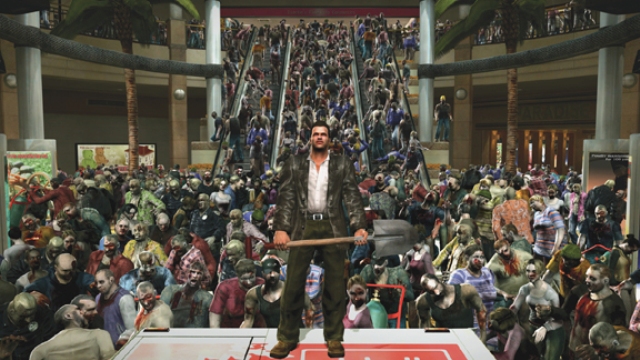
UNIQUE COPY: Going back to play Dead Rising now, six years on, it shows its age in more ways than one. Chunky controls, ropey visuals and the kind of regimented boss fights that give away a Capcom game like a bird dog gives away pheasants remind you at every turn that this title hit shelves in this generation’s infancy, but there’s still an undeniable quality and appeal to Frank’s adventure.
Ultimately, Dead Rising’s premise of embattled survivors fighting against a zombie invasion in a shopping mall might have more than insubstantial connections to the works of George Romero, but it’s very much its own beast – and that goes for the gameplay, too. Third person action games with a focus on melee have always been common, but mixing in zombies, dressing up, silly weapons, crazed bosses, an oppressive passage of time, RPG-style levelling and photography made Dead Rising incredibly original; and it remains so today.
The next generation of consoles will undoubtedly bring a slew of reboots, remakes and reimaginings on the improved tech and, despite my usual reservations about the bastardisation of anything that is already great, a reboot of Dead Rising might not be that bad provided the core gameplay is faithfully transplanted. Is it necessary? No. But it could be interesting. Dead Rising is considered a triumph of this generation for a reason, and might be called a “classic” by those who believe anything so young can be called a classic, because it’s such a solid example of game design.
A great open world, a persistent countdown that lends a sense of urgency and involvement, interesting, compelling characters and so much content that you’ll never see it all in one sitting mark Dead Rising out as one of the best games of the current generation, and I’d urge anyone who hasn’t played it to give it a whirl before the Durango and the Orbis arrive with their silly codenames, shiny new graphics and rumoured disrespect for backwards compatibility. And I urge you because I am one of those people, and Dead Rising is certainly a classic.




